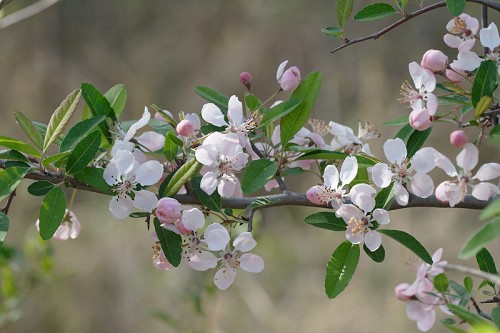Difference between revisions of "Malus angustifolia"
(→Ecology) |
|||
| Line 48: | Line 48: | ||
<!--===Fire ecology===--> <!--Fire tolerance, fire dependence, adaptive fire responses--> | <!--===Fire ecology===--> <!--Fire tolerance, fire dependence, adaptive fire responses--> | ||
| − | ===Pollination=== | + | ===Pollination and use by animals=== |
| − | ''M. angustifolia'' is mainly pollinated by bees and occasionally butterflies.<ref name ="FFE">Shared by Lisa Roberts; original post by Florida Wildflower Foundation; March 17, 2017, post shared to Florida Flora and Ecosystematics Facebook Group march 17, 2017. </ref> | + | ''M. angustifolia'' is mainly pollinated by bees and occasionally butterflies.<ref name ="FFE">Shared by Lisa Roberts; original post by Florida Wildflower Foundation; March 17, 2017, post shared to Florida Flora and Ecosystematics Facebook Group march 17, 2017. </ref> Whitetail deer, as well as bobwhites, grouse, pheasants, rabbits, squirrels, possums, raccoons, skunks, foxes, and other small birds will eat the fruit of the tree.<ref name= "USDA"> [https://plants.usda.gov/core/profile?symbol=CEAM USDA Plant Database]</ref> |
| − | + | ||
| − | Whitetail deer, as well as bobwhites, grouse, pheasants, rabbits, squirrels, possums, raccoons, skunks, foxes, and other small birds will eat the fruit of the tree.<ref name= "USDA"> [https://plants.usda.gov/core/profile?symbol=CEAM USDA Plant Database]</ref> | ||
===Diseases and parasites=== | ===Diseases and parasites=== | ||
''M angustifolia'' is prone to fireblight, cedar apple rust, apple scab, canker, scale, borers, and aphids.<ref name= "USDA"> [https://plants.usda.gov/core/profile?symbol=CEAM USDA Plant Database]</ref> | ''M angustifolia'' is prone to fireblight, cedar apple rust, apple scab, canker, scale, borers, and aphids.<ref name= "USDA"> [https://plants.usda.gov/core/profile?symbol=CEAM USDA Plant Database]</ref> | ||
Revision as of 18:26, 14 June 2021
Common names: Wild crabapple[1]
| Malus angustifolia | |
|---|---|

| |
| Photo by the Southeastern Flora Database | |
| Scientific classification | |
| Kingdom: | Plantae |
| Division: | Magnoliophyta - Flowering plants |
| Class: | Magnoliopsida - Dicots |
| Order: | Rosales |
| Family: | Rosaceae |
| Genus: | Malus |
| Species: | M. angustifolia |
| Binomial name | |
| Malus angustifolia Michx. | |

| |
| Natural range of Malus angustifolia from USDA NRCS Plants Database. | |
Contents
Taxonomic Notes
Synonyms: Pyrus angustifolia (Aiton), Pyrus angustifolia var. angustifolia, Pyrus angustifolia var. spinosa (Rehder) L.H. Bailey.[1]
Varieties: none.[1]
Description
M. angustifolia is a perennial shrub/tree of the Rosaceae family that is native to North America.[2]
Distribution
M. angustifolia is found throughout the southeastern United States; specifically in Florida, Georgia, Alabama, South Carolina, North Carolina, Virginia, Maryland, Pennsylvania, New Jersey, Deleware, West Virginia, Ohio, Kentucky, Tennessee, Arkansas, Mississippi, Louisiana, and Texas.[2]
Ecology
Habitat
Ideal habitats for the M. angustifolia are well-drained but moist valleys or other slopes, streambeds, woodland borders, old fields in the southeast, and even fence rows. It requires full sun for successful fruit and flowers.[2]
Dry hammocks and occasionally bottomlands are habitats for M. angustifolia.[3] Specimens have been collected from loamy sand in xeric flatwoods, mesic woodland, pine flatwoods, pine woods, fence row, floodplain, upland mixed woodland, deciduous woods, cultivated field, mesic hammock, sandy loam, wood bottoms, and thickets.[4]
M. angustifolia responds negatively to agricultural-based soil disturbance in South Carolina Coastal Plain communities. This marks it as an indicator species for remnant woodland.[5]
Malus angustifolia is an indicator species for the Clayhill Longleaf Woodlands community type as described in Carr et al. (2010).[6]
Phenology
M. angustifolia flowers April through May and fruits from August through September.[1]
Pollination and use by animals
M. angustifolia is mainly pollinated by bees and occasionally butterflies.[7] Whitetail deer, as well as bobwhites, grouse, pheasants, rabbits, squirrels, possums, raccoons, skunks, foxes, and other small birds will eat the fruit of the tree.[2]
Diseases and parasites
M angustifolia is prone to fireblight, cedar apple rust, apple scab, canker, scale, borers, and aphids.[2]
Conservation, cultivation, and restoration
Florida has classified M. angustifolia as threatened; it is endangered in Illinois and of special concern in Kentucky.[2]
Cultural use
Photo Gallery
References and notes
- ↑ 1.0 1.1 1.2 1.3 Weakley, A.S. 2015. Flora of the southern and mid-atlantic states. Working Draft of 21 May 2015. University of North Carolina at Chapel Hill, Chapel Hill, North Carolina.
- ↑ 2.0 2.1 2.2 2.3 2.4 2.5 USDA Plant Database
- ↑ Weakley, A. S. (2015). Flora of the Southern and Mid-Atlantic States. Chapel Hill, NC, University of North Carolina Herbarium.
- ↑ URL: http://herbarium.bio.fsu.edu. Last accessed: June 2018. Collectors: Loran C. Anderson, R.K. Godfrey, Patricia Elliot, John C. Ogden, R L Lazor, L R Fox, K Craddock Burks, Gary R Knight, R A Norris, M R Darst, R Komarek, H Roth, M Jenkins, Elmar C Prichard. States and counties: Florida (Wakulla, Leon, Gadsden, Jefferson, Liberty, Washington), Georgia (Thomas, Grady), North Carolina (Cumberland)
- ↑ Brudvig, L.A., E Grman, C.W. Habeck, and J.A. Ledvina. (2013). Strong legacy of agricultural land use on soils and understory plant communities in longleaf pine woodlands. Forest Ecology and Management 310: 944-955.
- ↑ Carr, S.C., K.M. Robertson, and R.K. Peet. 2010. A vegetation classification of fire-dependent pinelands of Florida. Castanea 75:153-189.
- ↑ Shared by Lisa Roberts; original post by Florida Wildflower Foundation; March 17, 2017, post shared to Florida Flora and Ecosystematics Facebook Group march 17, 2017.